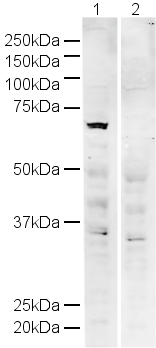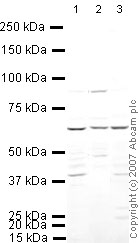Anti-IRF5 antibody - ChIP Grade
| Name | Anti-IRF5 antibody - ChIP Grade |
|---|---|
| Supplier | Abcam |
| Catalog | ab21689 |
| Prices | $382.00 |
| Sizes | 100 µg |
| Host | Rabbit |
| Clonality | Polyclonal |
| Isotype | IgG |
| Applications | ChIPseq WB |
| Species Reactivities | Mouse, Rat, Human, Bovine |
| Antigen | Synthetic peptide conjugated to BSA derived from within residues 450 to the C-terminus of Human IRF5 |
| Blocking Peptide | Human IRF5 peptide |
| Description | Rabbit Polyclonal |
| Gene | IRF5 |
| Conjugate | Unconjugated |
| Supplier Page | Shop |
Product images
Product References
Transcription factor IRF5 drives P2X4R+-reactive microglia gating neuropathic - Transcription factor IRF5 drives P2X4R+-reactive microglia gating neuropathic
Masuda T, Iwamoto S, Yoshinaga R, Tozaki-Saitoh H, Nishiyama A, Mak TW, Tamura T, Tsuda M, Inoue K. Nat Commun. 2014 May 13;5:3771.
IRF5:RelA interaction targets inflammatory genes in macrophages. - IRF5:RelA interaction targets inflammatory genes in macrophages.
Saliba DG, Heger A, Eames HL, Oikonomopoulos S, Teixeira A, Blazek K, Androulidaki A, Wong D, Goh FG, Weiss M, Byrne A, Pasparakis M, Ragoussis J, Udalova IA. Cell Rep. 2014 Sep 11;8(5):1308-17.
Genome-wide profiling of target genes for the systemic lupus - Genome-wide profiling of target genes for the systemic lupus
Wang C, Sandling JK, Hagberg N, Berggren O, Sigurdsson S, Karlberg O, Ronnblom L, Eloranta ML, Syvanen AC. Ann Rheum Dis. 2013 Jan;72(1):96-103.
Epigenetic silencing of IRF7 and/or IRF5 in lung cancer cells leads to increased - Epigenetic silencing of IRF7 and/or IRF5 in lung cancer cells leads to increased
Li Q, Tainsky MA. PLoS One. 2011;6(12):e28683.
IRF5 promotes inflammatory macrophage polarization and TH1-TH17 responses. - IRF5 promotes inflammatory macrophage polarization and TH1-TH17 responses.
Krausgruber T, Blazek K, Smallie T, Alzabin S, Lockstone H, Sahgal N, Hussell T, Feldmann M, Udalova IA. Nat Immunol. 2011 Mar;12(3):231-8.
Interferon regulatory factors IRF5 and IRF7 inhibit growth and induce senescence - Interferon regulatory factors IRF5 and IRF7 inhibit growth and induce senescence
Li Q, Tang L, Roberts PC, Kraniak JM, Fridman AL, Kulaeva OI, Tehrani OS, Tainsky MA. Mol Cancer Res. 2008 May;6(5):770-84.

